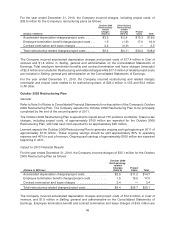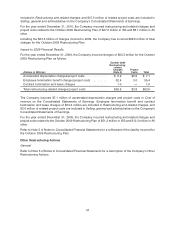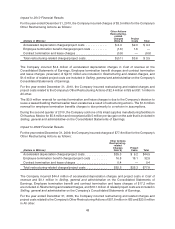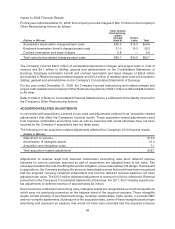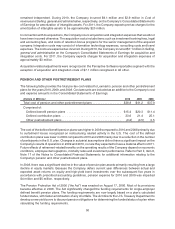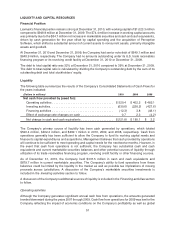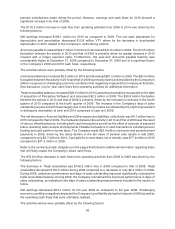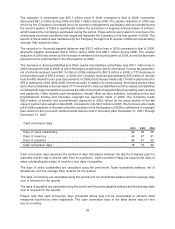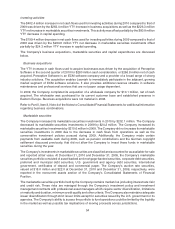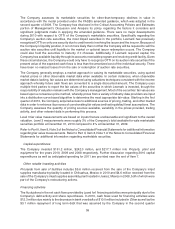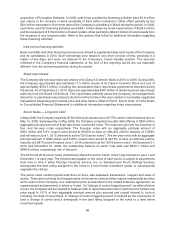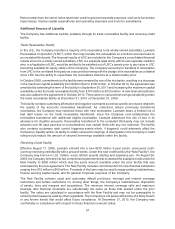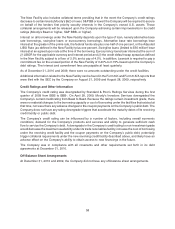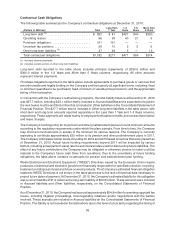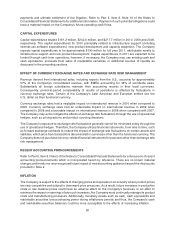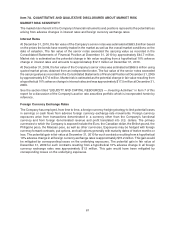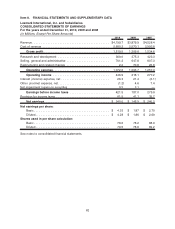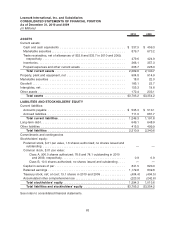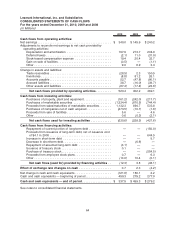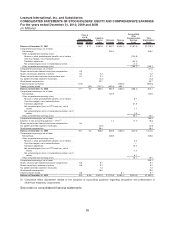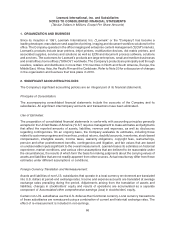Lexmark 2010 Annual Report Download - page 62
Download and view the complete annual report
Please find page 62 of the 2010 Lexmark annual report below. You can navigate through the pages in the report by either clicking on the pages listed below, or by using the keyword search tool below to find specific information within the annual report.acquisition of Perceptive Software. In 2009, cash flows provided by financing activities were $3.8 million
due mainly to the increase in bank overdrafts of $9.9 million included in Other offset partially by the
$6.6 million decrease in short-term debt of the Company’s subsidiary in Brazil during the period. In 2008,
cash flows used for financing activities were $48.1 million driven by share repurchases of $554.5 million
and the repayment of $150.0 million of maturing debt, offset partially by $644.5 million of net proceeds from
the issuance of new long-term debt. Refer to the sections that follow for additional information regarding
these financing activities.
Intra-period financing activities
Bank overdrafts and other financing sources were utilized to supplement daily cash needs of the Company
and its subsidiaries in 2010. Such borrowings were repaid in very short periods of time, generally in a
matter of few days, and were not material to the Company’s overall liquidity position. The amounts
reflected in the Company’s financial statements at the end of the reporting period are not materially
different from the borrowing activities during the period.
Share repurchases
The Company did not repurchase any shares of its Class A Common Stock in 2010 or 2009. During 2008,
the Company repurchased approximately 17.5 million shares of its Class A Common Stock at a cost of
approximately $554.5 million, including two accelerated share repurchase agreements executed during
the period. As of December 31, 2010, there was approximately $491 million of remaining share repurchase
authority from the Board of Directors. This repurchase authority allows the Company, at management’s
discretion, to selectively repurchase its stock from time to time in the open market or in privately negotiated
transactions depending upon market price and other factors. Refer to Part II, Item 8, Note 15 of the Notes
to Consolidated Financial Statements for additional information regarding share repurchases.
Senior Notes — Long-term Debt
In May 2008, the Company repaid its $150 million principal amount of 6.75% senior notes that were due on
May 15, 2008. Subsequently, in May 2008, the Company completed a public debt offering of $650 million
aggregate principal amount of fixed rate senior unsecured notes. The notes are split into two tranches of
five- and ten-year notes respectively. The five-year notes with an aggregate principal amount of
$350 million and 5.9% coupon were priced at 99.83% to have an effective yield to maturity of 5.939%
and will mature June 1, 2013 (referred to as the “2013 senior notes”). The ten-year notes with an aggregate
principal amount of $300 million and 6.65% coupon were priced at 99.73% to have an effective yield to
maturity of 6.687% and will mature June 1, 2018 (referred to as the “2018 senior notes”). At December 31,
2010 and December 31, 2009, the outstanding balance of senior note debt was $649.1 million and
$648.9 million, respectively, net of discount.
The 2013 and 2018 senior notes (collectively referred to as the “senior notes”) pay interest on June 1 and
December 1 of each year. The interest rate payable on the notes of each series is subject to adjustments
from time to time if either Moody’s Investors Service, Inc. or Standard and Poor’s Ratings Services
downgrades the debt rating assigned to the notes to a level below investment grade, or subsequently
upgrades the ratings.
The senior notes contain typical restrictions on liens, sale leaseback transactions, mergers and sales of
assets. There are no sinking fund requirements on the senior notes and they may be redeemed at any time
at the option of the Company, at a redemption price as described in the related indenture agreement, as
supplemented and amended, in whole or in part. If a “change of control triggering event” as defined below
occurs, the Company will be required to make an offer to repurchase the notes in cash from the holders at a
price equal to 101% of their aggregate principal amount plus accrued and unpaid interest to, but not
including, the date of repurchase. A “change of control triggering event” is defined as the occurrence of
both a change of control and a downgrade in the debt rating assigned to the notes to a level below
investment grade.
56


